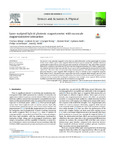Laser-sculpted hybrid photonic magnetometer with nanoscale magnetostrictive interaction
| dc.contributor.author | Allsop, T | |
| dc.contributor.author | Lee, GB | |
| dc.contributor.author | Wang, C | |
| dc.contributor.author | Neal, R | |
| dc.contributor.author | Kalli, K | |
| dc.contributor.author | Culverhouse, Phil | |
| dc.contributor.author | Webb, DJ | |
| dc.date.accessioned | 2018-02-27T13:31:31Z | |
| dc.date.available | 2018-02-27T13:31:31Z | |
| dc.date.issued | 2018 | |
| dc.identifier.issn | 0924-4247 | |
| dc.identifier.uri | http://hdl.handle.net/10026.1/10884 | |
| dc.description | keywords: Magnetostrictive material, Long period gratings, Optical sensing, Magnetic sensors | |
| dc.description.abstract |
We present a new photonic magnetic sensor that can yield information on the spatial angle of rotation of the sensor within a given static magnetic field that based upon an optical fiber platform that has a wavelength-encoded output and a demonstrated sensitivity of 543 pm/mT. This optical fiber magnetic field sensor combines a conventional, UV-laser inscribed long period grating (LPG) with a magnetostrictive material Terfenol-D that coats and fills 50-μm micro-slots running adjacent and parallel to the fiber central axis. The micro-slots are produced using a femtosecond laser and selective chemical etching. A detection limit for a static magnetic field strength of ±50 μT is realized in low strength DC magnetic field (below 0.4 mT), this performance approaches the Earth’s magnetic field strength and thus, once optimized, has potential for navigation applications. Our method addresses the major drawback of conventional sensors, namely their inadequate sensitivity to low strength, static magnetic fields and their inability to provide information about the orientation and magnitude. | |
| dc.format.extent | 545-555 | |
| dc.language | en | |
| dc.language.iso | en | |
| dc.publisher | Elsevier BV | |
| dc.subject | Magnetostrictive material | |
| dc.subject | Long period gratings | |
| dc.subject | Optical sensing | |
| dc.subject | Magnetic sensors | |
| dc.title | Laser-sculpted hybrid photonic magnetometer with nanoscale magnetostrictive interaction | |
| dc.type | journal-article | |
| dc.type | article | |
| plymouth.author-url | https://www.webofscience.com/api/gateway?GWVersion=2&SrcApp=PARTNER_APP&SrcAuth=LinksAMR&KeyUT=WOS:000423887500060&DestLinkType=FullRecord&DestApp=ALL_WOS&UsrCustomerID=11bb513d99f797142bcfeffcc58ea008 | |
| plymouth.volume | 269 | |
| plymouth.publisher-url | http://www.sciencedirect.com/science/article/pii/S0924424717306970 | |
| plymouth.publication-status | Published | |
| plymouth.journal | Sensors and Actuators A: Physical | |
| dc.identifier.doi | 10.1016/j.sna.2017.12.021 | |
| plymouth.organisational-group | /Plymouth | |
| plymouth.organisational-group | /Plymouth/Faculty of Science and Engineering | |
| plymouth.organisational-group | /Plymouth/Research Groups | |
| plymouth.organisational-group | /Plymouth/Research Groups/Marine Institute | |
| dcterms.dateAccepted | 2017-12-11 | |
| dc.rights.embargoperiod | Not known | |
| rioxxterms.funder | EPSRC | |
| rioxxterms.identifier.project | Grating and waveguide plasmonic sensors | |
| rioxxterms.versionofrecord | 10.1016/j.sna.2017.12.021 | |
| rioxxterms.licenseref.uri | http://www.rioxx.net/licenses/all-rights-reserved | |
| rioxxterms.type | Journal Article/Review | |
| plymouth.funder | Grating and waveguide plasmonic sensors::EPSRC |


